In the wake of the pandemic, many teachers have shared their concerns about reading skills. Anecdotally, a troubling number of students—more than usual—appear to be struggling with reading and interpreting texts.
Now we know that’s true.
In June 2023, the National Assessment of Educational Progress (NAEP), a congressionally mandated project within the U.S. Department of Education, released the results of their 2022 Reading Assessment Report Card, the first report since before the pandemic. And frankly, the findings are concerning.
The Test
Administered to fourth- and eighth-grade students every two years, the NAEP Reading Assessment is intended to measure reading proficiency. NAEP defines reading as a complex cognitive process that involves understanding written text, developing and interpreting meaning, and using meaning as appropriate to the type of text (2022 Reading Assessment).
Students must read both literary and informational texts during the assessment, including fiction, poetry, procedural texts, documents, and persuasive pieces. Accompanying questions measure students’ abilities to locate and recall, integrate and interpret, and critique and evaluate. Question difficulty and quantity vary by grade level.
The assessment was last conducted in 2019 and was delayed because of the pandemic. This year’s results include national, regional, and state data. For the purposes of this post, we’ll be focusing on highlights from the report.
The Results
Trend in Fourth- And Eighth-Grade Reading Average Scores
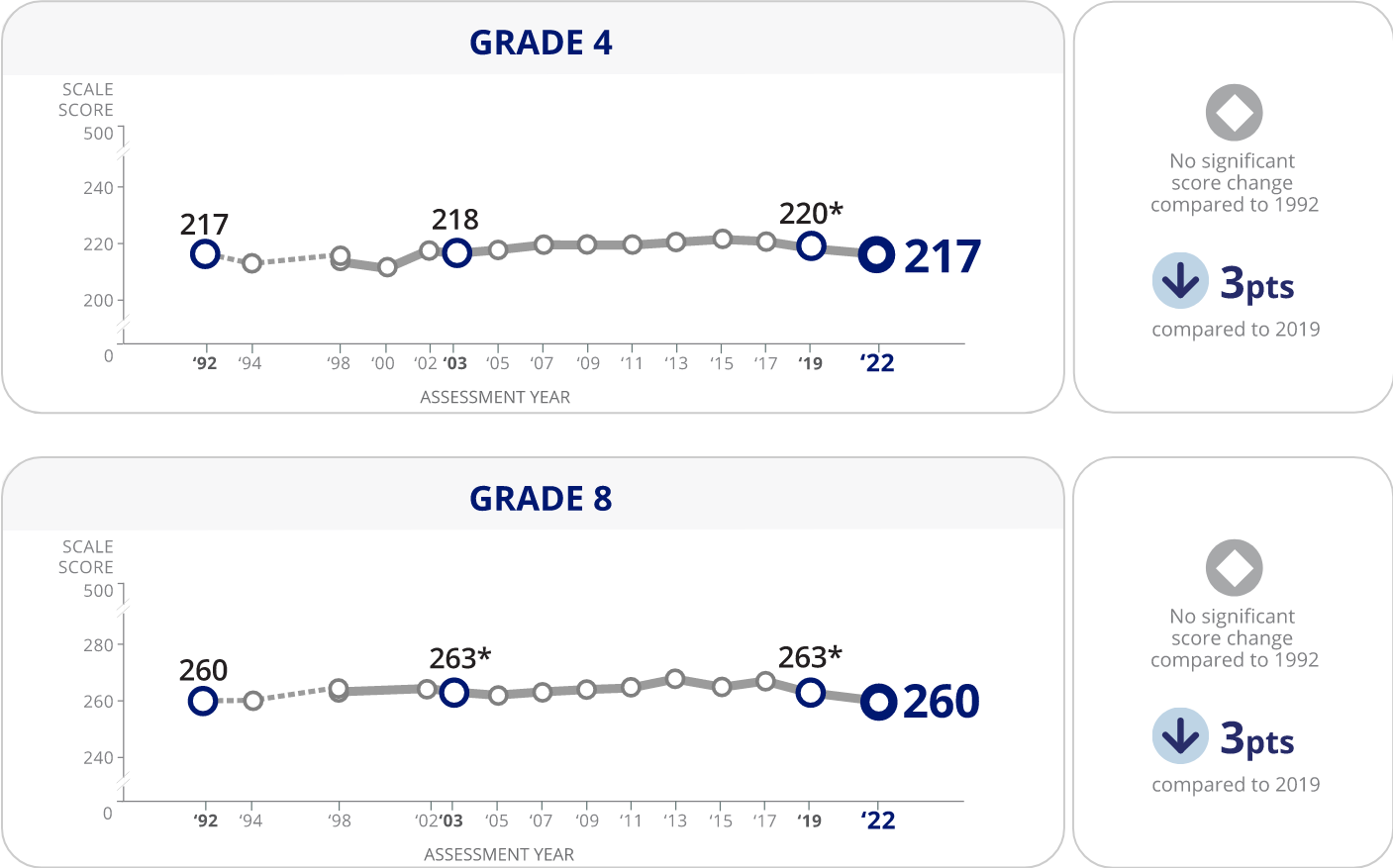
Source: U.S. Department of Education
Overall, reading proficiency among fourth and eighth graders has fallen to its lowest levels in decades for almost all demographics and ability levels. Nationally, fourth-grade student scores averaged 217 out of 500, down from 220 in 2019, the last year the test was administered. Eighth-grade scores dropped to 260 out of 500, three points less than the previous assessment.
Fourth Grade
Change in Average Scores Between 2019 and 2022 for Fourth-Grade Public School Students in NAEP Reading, By State/Jurisdiction
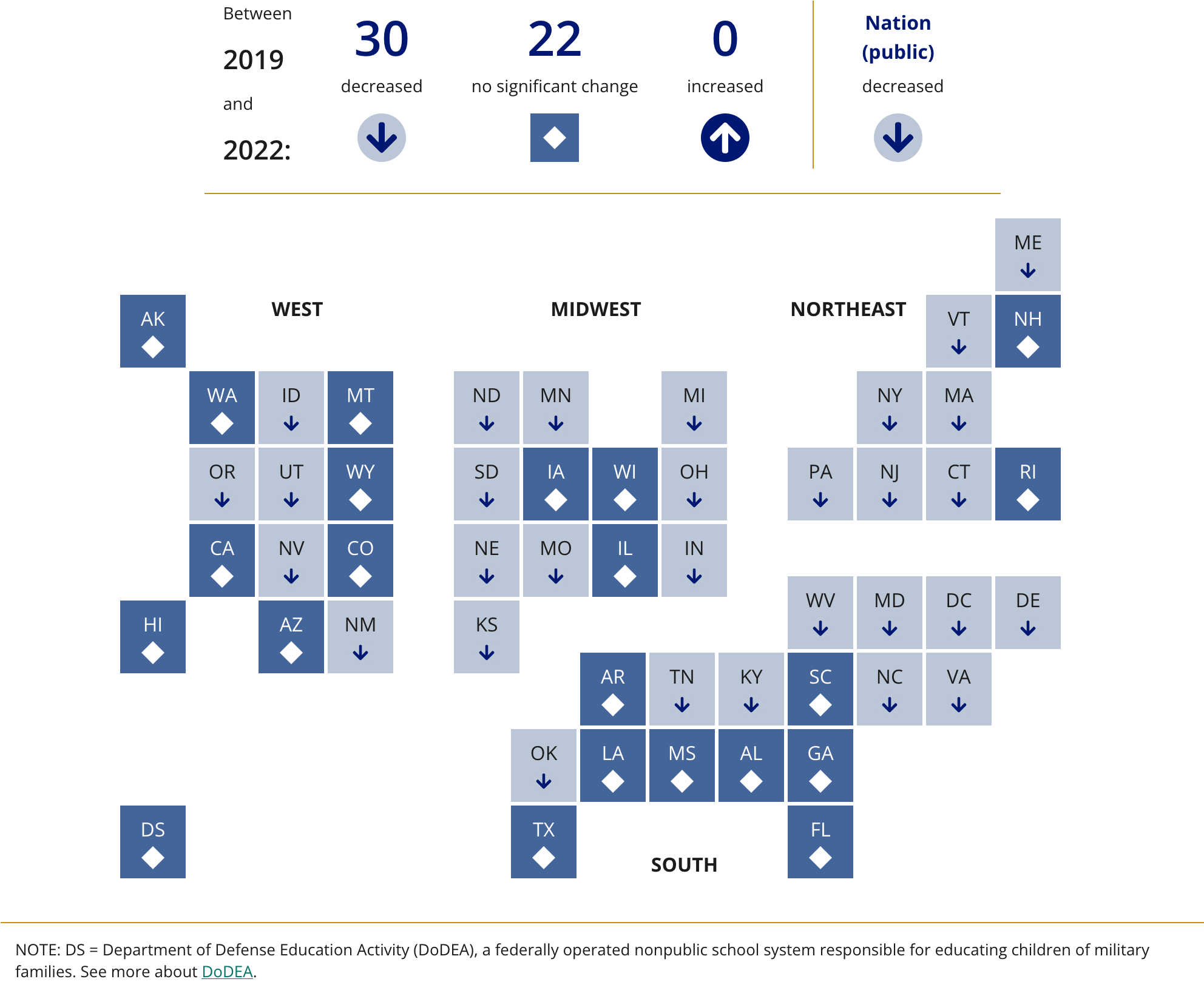
Source: U.S. Department of Education
Average fourth-grade reading scores fell in all regions of the country: West, Midwest, Northeast, and South. Compared to 2019, scores were lower by 2 points in the West, 3 points in the Midwest, 5 points in the Northeast, and 3 points in the South.
At the state/jurisdiction level, average fourth-grade reading scores fell in 30 states, the largest number since the initial assessment in 1992. Scores were not significantly different to 2019 numbers in 22 states/jurisdictions.
Changes in Fourth-Grade NAEP Reading Scores at Five Selected Percentiles: 2019 and 2022
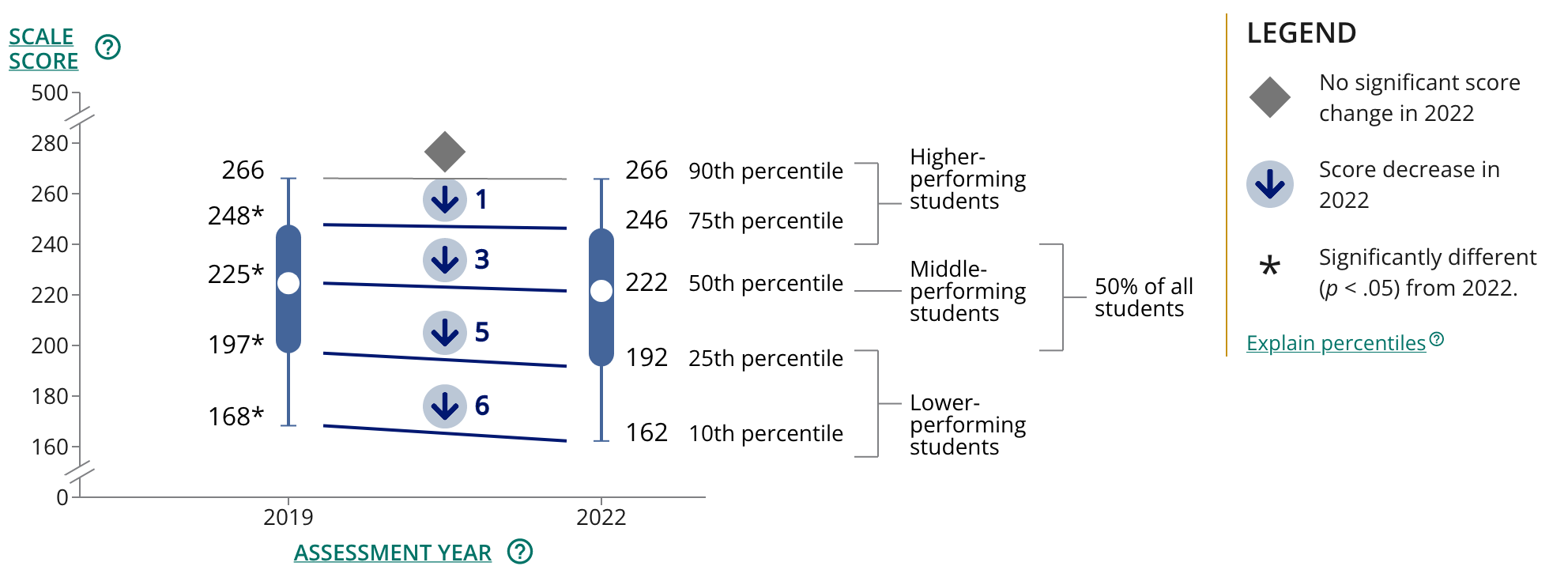
Source: U.S. Department of Education
NAEP reports scores at five selected percentiles to show progress made by lower- (10th and 25th percentiles), middle- (50th percentile), and higher- (75th and 90th percentiles) performing students. In 2022, fourth-grade reading scores fell for students performing at the 10th, 25th, 50th, and 75th percentiles compared to 2019. There was no significant change for the highest-performing students at the 90th percentile.
Changes in Fourth-Grade NAEP Reading Scores Between 2019 and 2022, by Selected Racial/Ethnic Groups
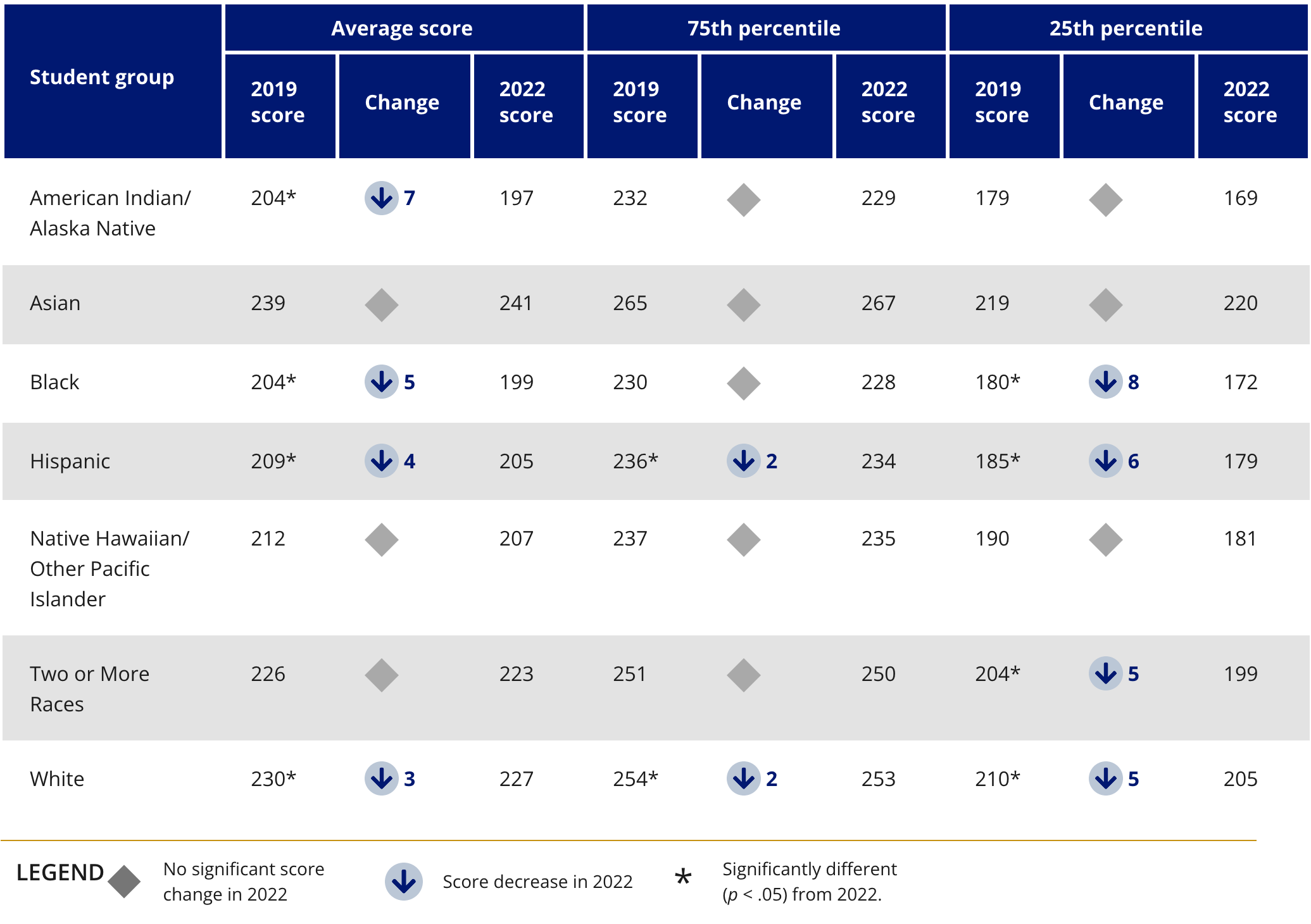
Source: U.S. Department of Education
In 2022, fourth-grade reading scores declined for most race/ethnicity groups compared to 2019. Results show that scores declined for American Indian/Alaska native, Black, Hispanic, and White students.
Performance at the lower (25th) and higher (75th) percentiles provides insight into the score declines for selected student groups. Compared to 2019, average scores in 2022 declined at the lower percentile for Black students and students of Two or More Races; scores declined at the lower and higher percentiles for Hispanic and White students.
Changes in Fourth-Grade NAEP Reading Scores Between 2019 and 2022, by Gender
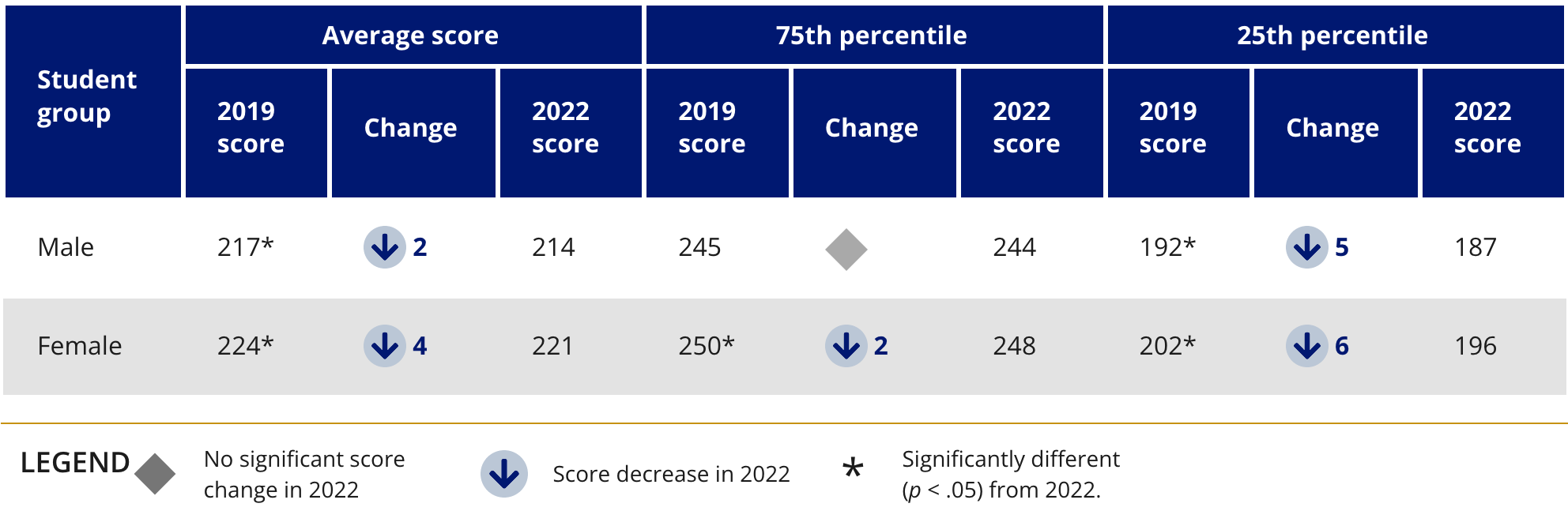
Source: U.S. Department of Education
Segmenting by gender, average scores declined at the lower and higher percentiles for female students while scores declined at the lower percentile for male students.
Changes in Fourth-Grade NAEP Reading Scores Between 2019 and 2022, by School Location
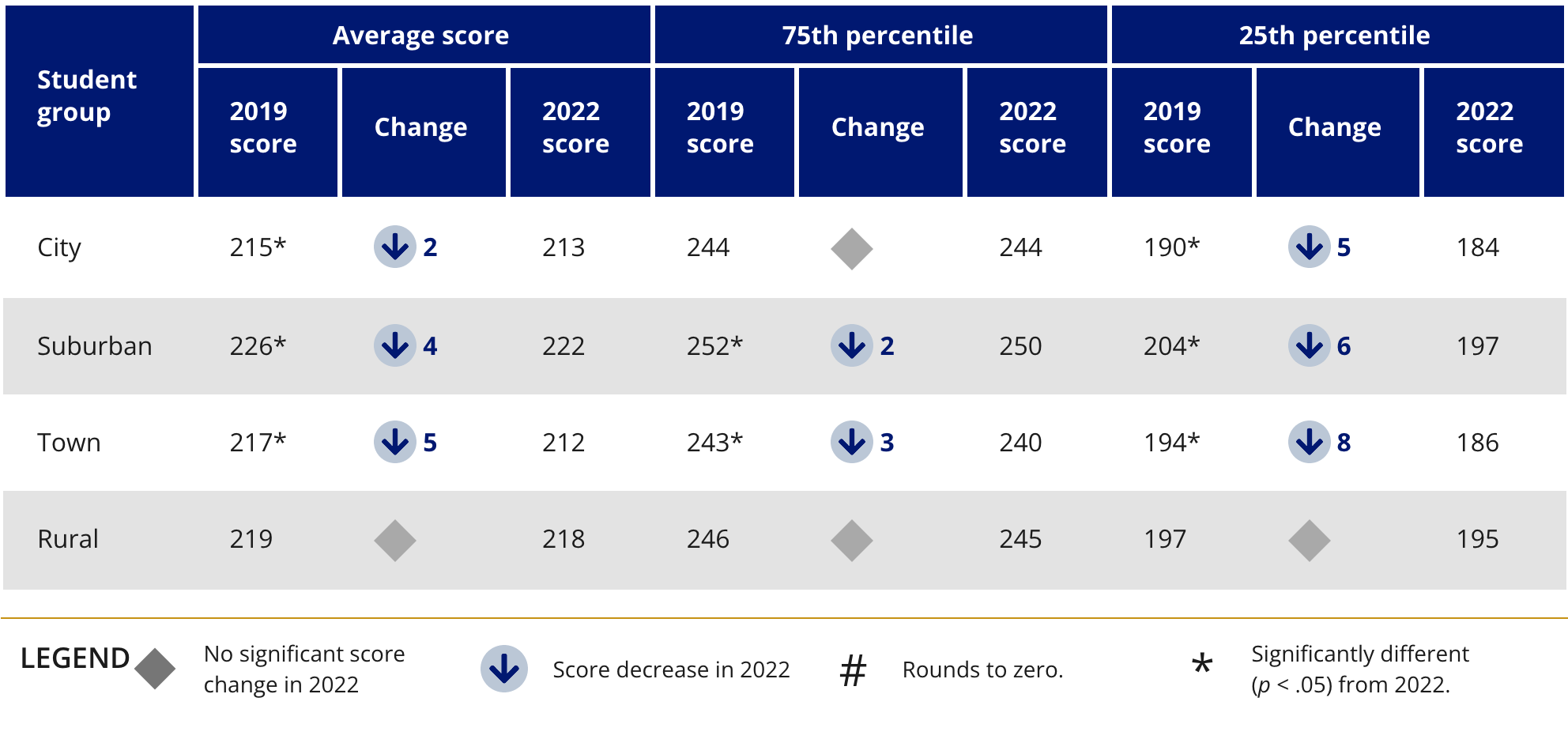
Source: U.S. Department of Education
Moving on to school location, average reading scores declined for fourth-graders attending schools in city, suburban, and town locations while the average score did not significantly change for students attending schools in rural locations.
Eighth Grade
Change in Average Scores Between 2019 and 2022 for Eighth-Grade Public School Students in NAEP Reading, By State/Jurisdiction
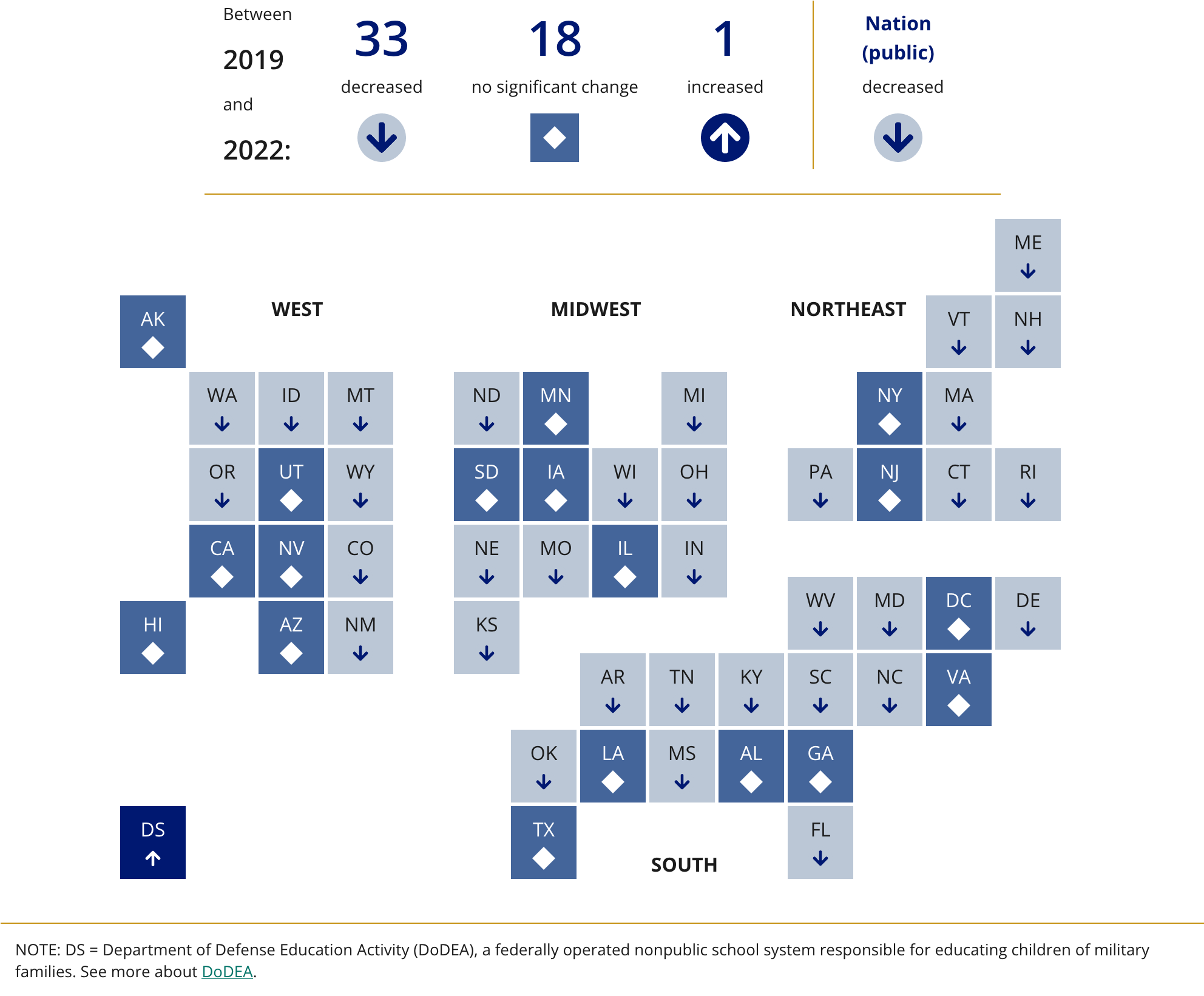
Source: U.S. Department of Education
At the regional level, average eighth-grade reading scores declined in the Northeast (2 points), Midwest (4 points), and South (3 points) compared to 2019. The average score did not significantly change in the West.
At the state/jurisdiction level, average eighth-grade reading scores fell in 33 states. Compared to 2019, scores were not significantly different in 18 states/jurisdictions. There was actually a score increase in one jurisdiction, the Department of Defense Education Activity (DoDEA), a federally operated nonpublic school system for children of military families.
Changes in Eighth-Grade NAEP Reading Scores at Five Selected Percentiles: 2019 and 2022
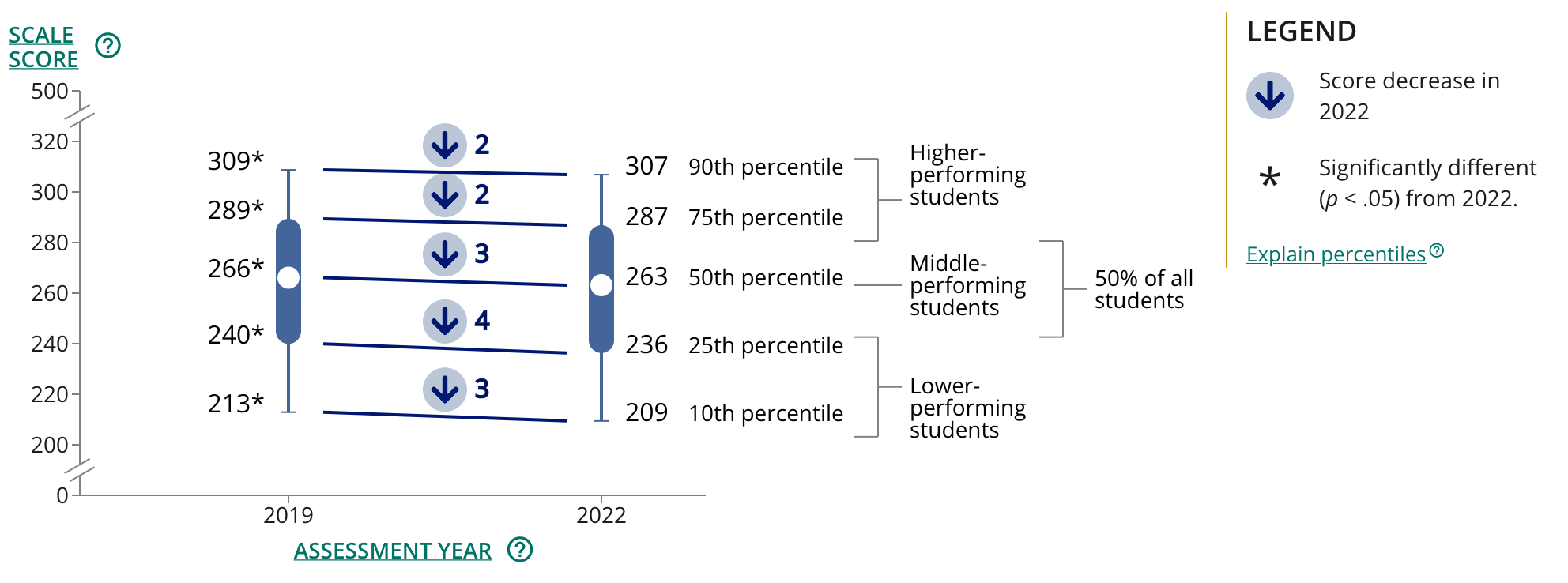
Source: U.S. Department of Education
Reading scores were lower in 2022 than in 2019 for eighth-graders across all five selected percentiles. Score declines for lower-performing students at the 10th and 25th percentiles (3 and 4 points) were not significantly different from the declines for higher-performing students at the 75th and 90th percentiles (both 2 points lower than in 2019).
Changes in Eighth-Grade NAEP Reading Scores Between 2019 and 2022, by Selected Racial/Ethnic Groups
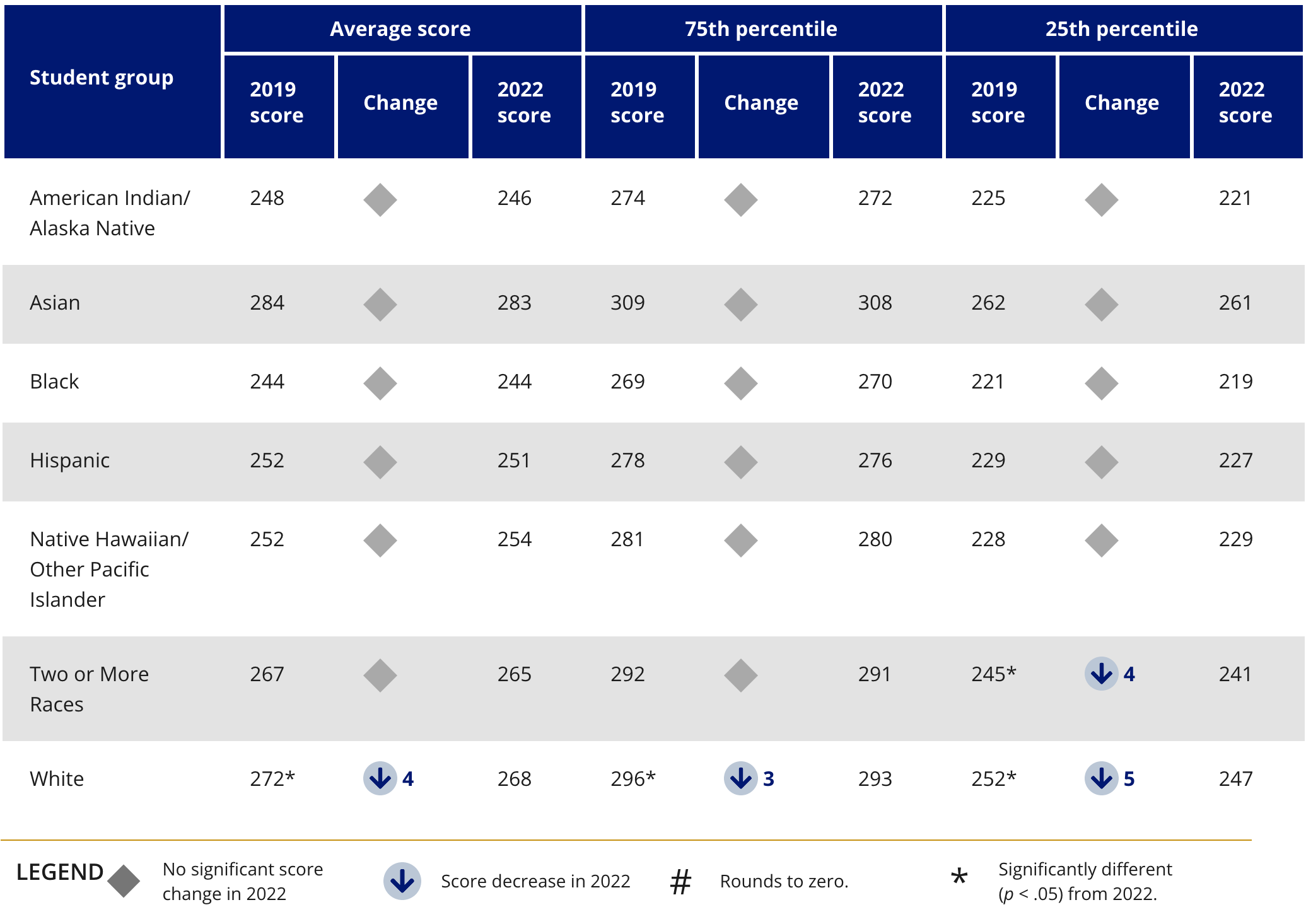
Source: U.S. Department of Education
In 2022, the average reading score didn’t change significantly for American Indian/Alaska Native, Asian, Black, Hispanic, and Native Hawaiian/Other Pacific Islander students, and students of Two or More Races. Scores declined by 4 points for White students.
Changes in Eighth-Grade NAEP Reading Scores Between 2019 and 2022, by Gender
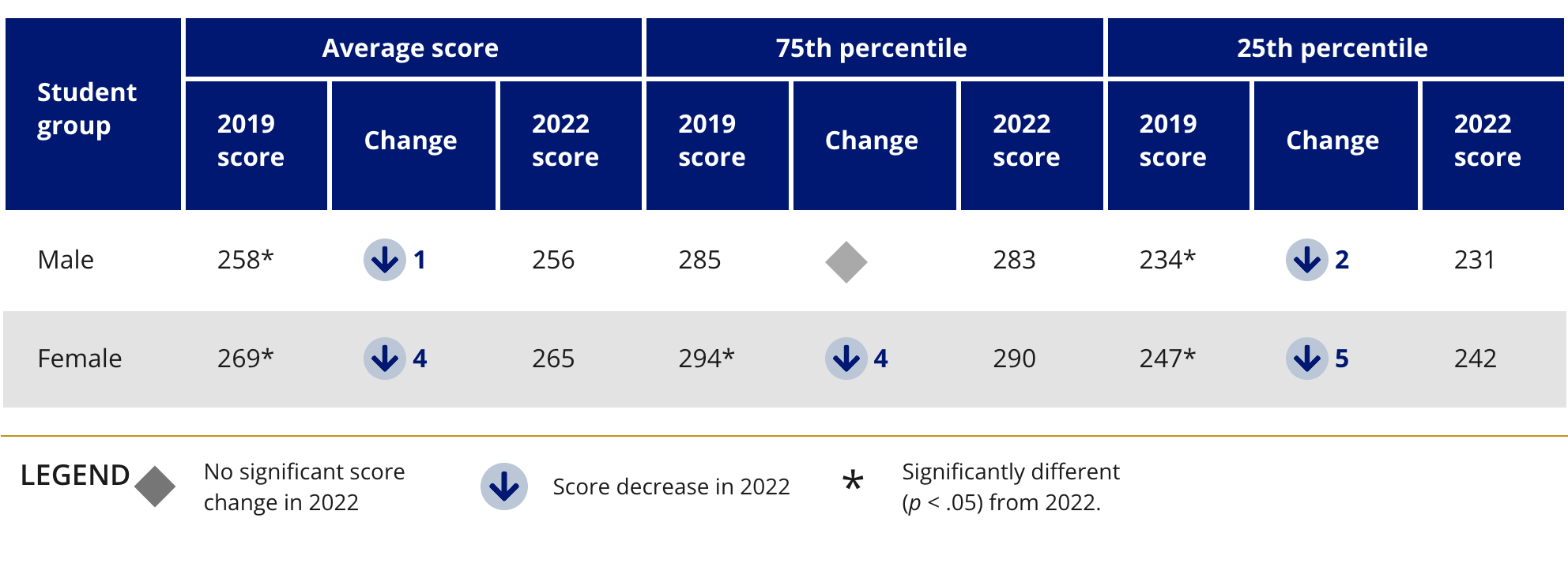
Source: U.S. Department of Education
Average reading scores decreased overall for male and female students compared to 2019. Although female students scored higher on average, the 4-point decline for female students was greater than the 1-point decline for male students. Scores in 2022 were lower compared to 2019 for female students at the lower and higher percentiles. Scores for male students declined only at the lower percentile.
Changes in Eighth-Grade NAEP Reading Scores Between 2019 and 2022, by School Location
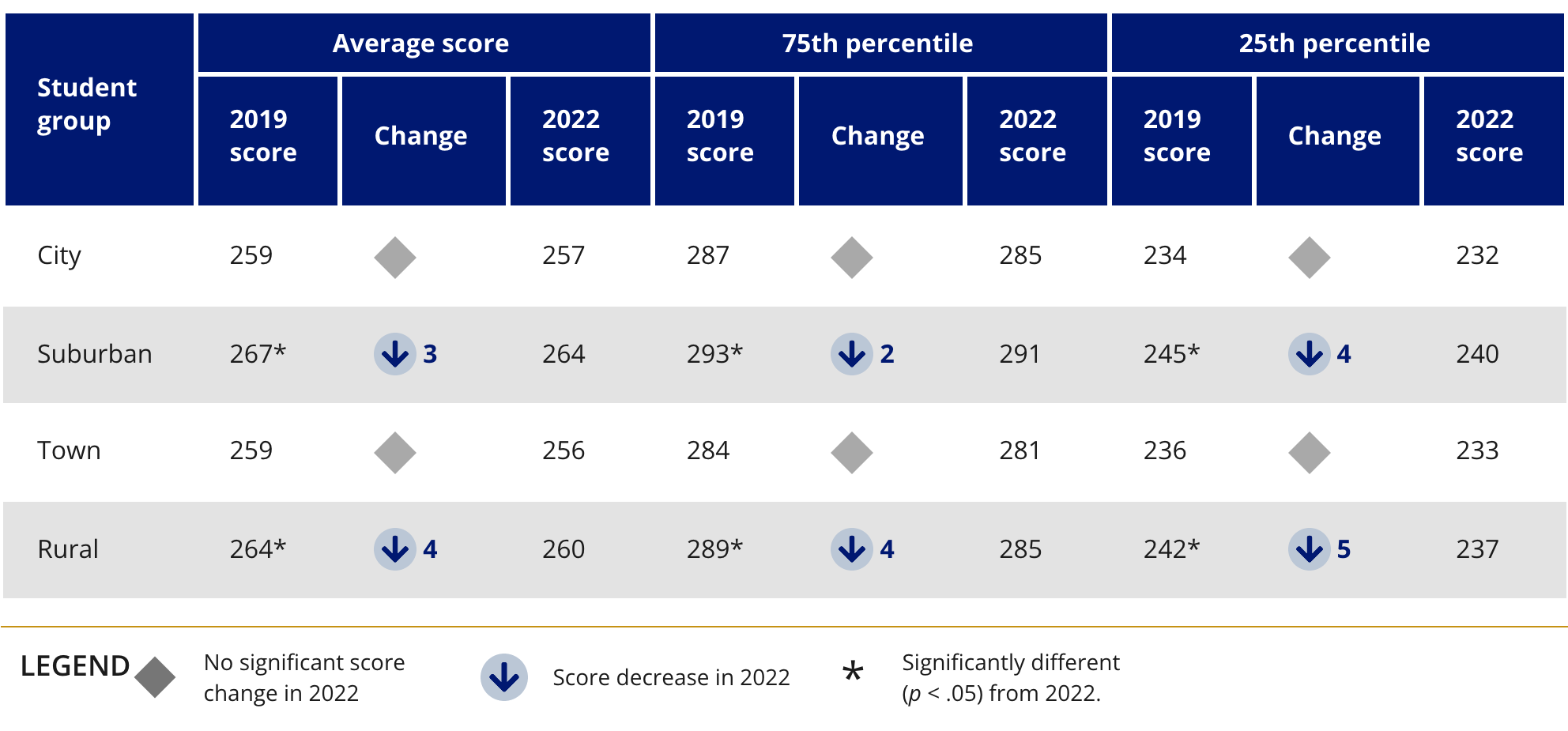
Source: U.S. Department of Education
Segmenting by school location, average scores decreased for students attending suburban and rural schools while scores did not significantly change for students attending city and town schools. Looking at selected percentile levels, scores declined at the lower and higher percentiles for students attending suburban and rural schools.
Reading Comprehension Results
The 2022 digitally based reading assessment at grades 4 and 8 used discrete question sets as well as scenario-based tasks. These consisted of sequences of connected questions and concepts integrated into a single real-world scenario. The assessment contained selected-response and constructed-response questions.
Change in Average Scores Between 2019 and 2022 for Fourth- and Eighth-grade Students in NAEP Reading, by Type of Texts

Source: U.S. Department of Education
Compared to 2019, average scores decreased for both literary and informational texts comprehension at both the fourth- and eighth-grade level.
Change in Average Scores Between 2019 and 2022 For Fourth- and Eighth-Grade Public School Students in NAEP Reading, by Type of Texts and by State/Jurisdiction and Participating District
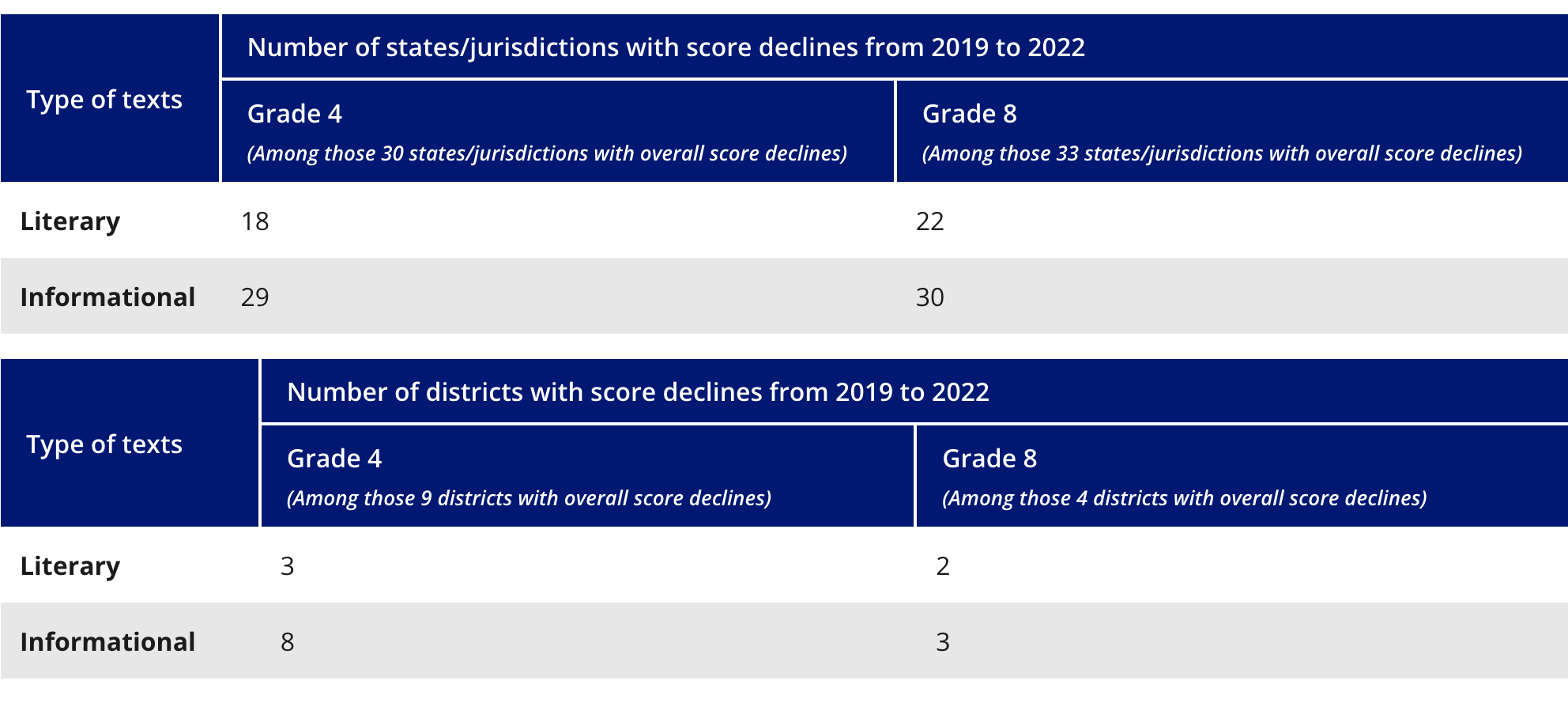
Source: U.S. Department of Education
Among the states/jurisdictions with overall average score declines between 2019 and 2022, 18 states/jurisdictions scored lower in 2022 than in 2019 on literary reading while 29 states scored lower on informational reading at grade 4. At eighth grade, 22 states scored lower in 2022 on literary reading and 30 states scored lower for informational reading.
For the full results of the 2022 Reading Assessment Report Card, see the NAEP’s official report.
Resources for Reading Instruction
With the renewed focus on improving outcomes for students, teachers have been reaching out looking for solutions that will help close the gap for students struggling with reading. At Prestwick House, we’re no stranger to building strong readers. Trusted by teachers and easy to implement in any curriculum, our reading and vocabulary programs ensure your students receive rigorous instruction without hours of prep work.
Reading Informational Texts and Reading Literature are two series designed to give your middle and high school students essential practice reading and analyzing difficult texts. In each book, you’ll find a selection of grade-appropriate passages and questions similar to those found in reading assessments. Every text features detailed sidebar annotations that highlight important elements, giving students just enough scaffolding to approach each exercise with confidence.
Practice Makes Perfect: Preparation for State Reading Assessments is a program designed specifically to help students feel comfortable with reading assessments without the pressure of the big test day. This program provides regular practice working with the types of texts and questions they’re likely to encounter on standardized tests. A wide selection of reading passages and accompanying questions on author’s purpose, main idea, tone, inferences, and other concepts are included in each book. Preparation for State Reading Assessments is available for grades 4 to 12.
Research in the science of reading identifies direct vocabulary instruction as one of the core pillars of effective reading instruction. Vocabulary Power Plus is our flagship vocabulary program built from the ground up to help students improve both vocabulary and reading comprehension skills. Lessons on new vocabulary words are followed up with critical reading and writing exercises modeled after common standardized tests. Students will define words in context, compare paired passages, improve paragraphs, and answer writing prompts, among other activities. With books for upper elementary, middle, and high school, Vocabulary Power Plus is the perfect program for improving student performance year after year.
Physical samples of these and other Prestwick House programs are available upon request. Simply send an email to info@prestwickhouse.com for more information. We’re happy to help!
Data and graphics source:
U.S. Department of Education. Institute of Education Sciences, National Center for Education Statistics, National Assessment of Educational Progress (NAEP), 2022 Reading Assessment. URL: https://www.nationsreportcard.gov/highlights/reading/2022/